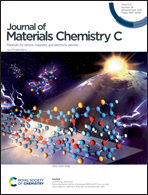Dynamic axial chirality of ferrocene diamino acids: hydration effects and chiroptical applications†
Abstract
Beyond merely as a solvent, water is increasingly recognized as an active constituent in physiochemical processes of artificial and biological systems. Its mysterious role in controlling the mechanical movement of chiral molecular systems has not been addressed so far. Here, we present unprecedented hydration-driven chiral molecular rotor systems based on the Herrick's conformation of N-terminated ferrocene diamino acids. In solid and solution phases, double intramolecular H-bonds fixed the orientation of amino acids to allow for chirality transfer to ferrocene, which demonstrated significant dependence on solvent environments. Water intercalation aroused the destruction of pristine H-bonds between adjacent amino acids and the formation of new H-bonds, driving the movement of diamino acid arms with increased dihedral angles. Water dynamics in molecular switching behavior were illustrated by proton NMR and DFT calculations that indicated the intercalation of water via multiple H-bonds. Hydration-triggered molecular movement caused pronounced variations to the induced axial chirality with switchable chiroptical responses. This work discloses the crucial role of water in chiral switchable molecular movement behavior, and provides a promising protocol for fabricating external field-responsive chiral materials.



 Please wait while we load your content...
Please wait while we load your content...